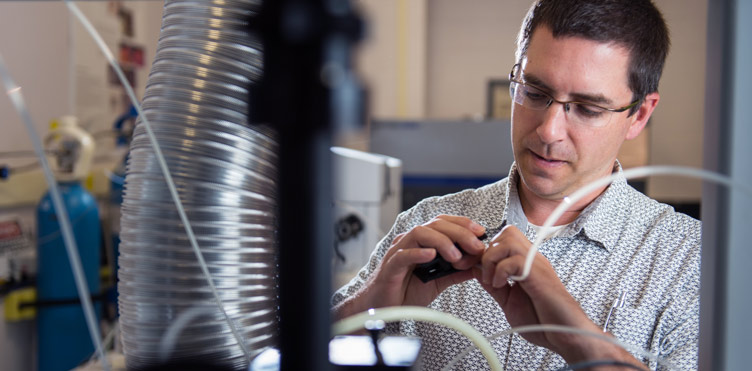Research

Our faculty and affiliated adjuncts conduct a wide variety of fundamental earth and environmental sciences research. This research is supported by comprehensive technical and infrastructure support, maintained by UNB Earth Sciences and other UNB facilities on campus. We also collaborate with provincial and federal government survey organizations, nearby universities and industry.
Allison Enright's research uses sensors and signal processing techniques to develop in situ monitoring technology and instruments. These instruments are deployed in a range of pristine and contaminated environments to study processes such as remediation, biogeochemical cycling, and for life detection.
Audrey Limoges’ research in Micropaleontology/Palynology combines data from different microfossil groups to obtain an integrated retrospective view on the state and change through time of virtually any kind of aquatic ecosystem in order to understand how a system responds to a changing environment.
Kynan Hughson’s research group investigates landscape and landform evolution to better understand the impact of groundwater, ground ice, and climate processes on the history and architecture of the surfaces of Earth and other planetary bodies in the solar system. Dr. Hughson’s current research projects focus on the synthesis of near-surface geophysical methods, such as resistivity tomography and ground penetrating radar, with high-resolution terrain modeling derived from remotely sensed imagery to constrain the dynamics and mechanics of hillslopes and periglacial landforms in alpine and periglacial terrains on Earth, Mars, and the dwarf planet Ceres.
Karl Butler’s group focusses on the use and development of geophysical methods for a variety of applications with depths of investigation ranging from decimetres to kilometres. He has special expertise in engineering, environmental and geological applications investigating conditions and processes in the so-called ‘Critical Zone’. His group has contributed markedly to the measurement and understanding of seismoelectric phenomena, to the characterization of fractured and granular aquifers, and to the development of geophysical monitoring methods for inferring the movement of water in the subsurface, including leakage through embankment dams.
Our research in Igneous Petrology/Experimental Petrology and related and applied Volcanology, led by Cliff Shaw and David Lentz, looks at understanding superheating, assimilation processes, fractionation and links to target geology as source rocks for the melting process.
Chris McFarlane and David Lentz research Metamorphic Petrology/Isotope Geology and aim to reconstruct the evolution of ancient mountain building events by examining the textural, geochemical, crystal-chemical, and isotopic systematics of major and accessory minerals. Their projects typically involve combinations of field and laboratory investigations supported by micro-analytical measurements to determine paleopressure and paleotemperature conditions as well as fluid chemistry, and assessments of open- and close-system behaviour.
UNB’s research of Ore Deposits Geology by David Lentz and Chris McFarlane is focused on the genesis of a variety of mineral deposits-forming systems, including their implications for exploration and resource evaluation; these include many critical mineral (metal) systems key for the transition to the Green Economy.
David Keighley focuses on Petroleum Geology/Sedimentology and the structures (including trace fossils), stratigraphy, and inorganic geochemistry of sedimentary rocks.
Bruce Broster studies applied glacial/quaternary geology, surficial environmental geoscience, and geological engineering, as well as collaborates on archeological studies.
Other research areas:
- Research facilities
- Biogeology, Paleoclimatology, Paleontology, Ichnology (Audrey Limoges, David Keighley)
- Engineering Geology, Rock Mechanics (Joseph White, Bruce Broster)
